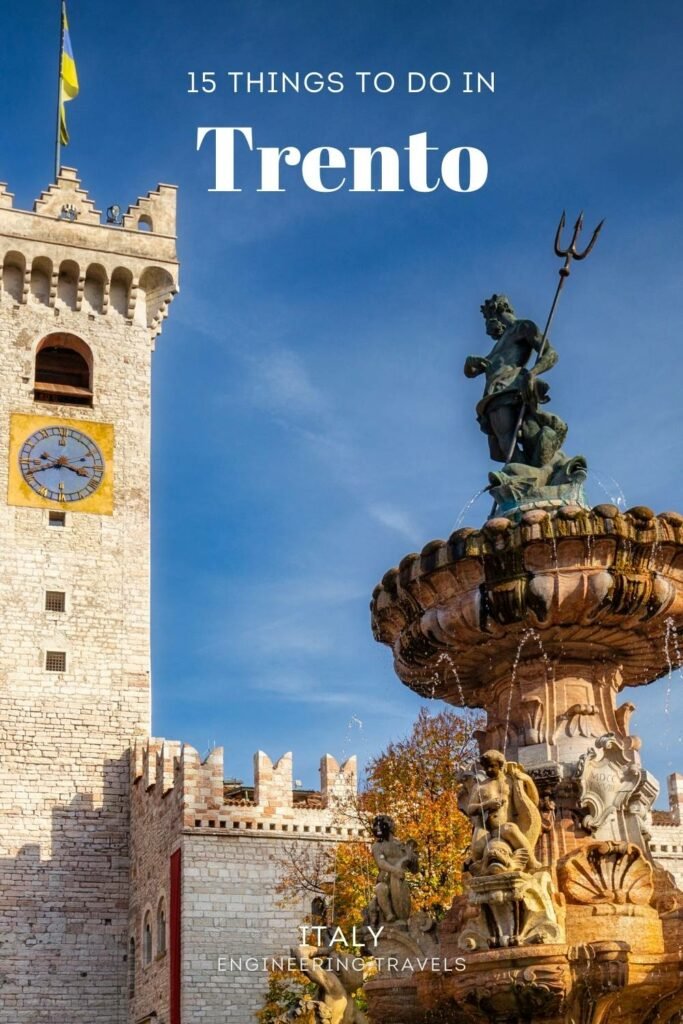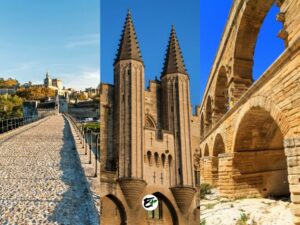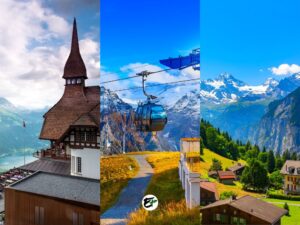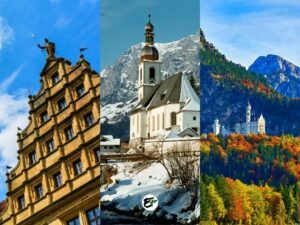Why You Should Visit Trento: Guide to Top 15 Things to Do
Traveling in Italy offers an interesting travel experience – the further north you venture, the more picturesque the landscapes become. This is particularly noticeable when you start from cities like Rome or Florence and head towards Cortina d’Ampezzo in the Dolomites. By the time you reach pre-Alps destinations such as Bergamo, Verona, Lake Como, or Lake Garda, the majestic mountains are already within sight.
Commonly, it’s believed that straying further from the bustling cities into more secluded areas leads to fewer historical and cultural discoveries. However, in Italy, this isn’t entirely true, especially in Northern Italy. Take Trento for instance.
Nestled in the Italian Alps, Trento boasts a rich heritage that spans from medieval castles to World War monuments. Trento also has little gems like mural-decorated houses in its squares and panoramic viewpoints, making the city even more worth exploring. And let’s not forget the surrounding mountains that offer refreshing views that can be admired directly from the town.
Are you curious what can you exactly find in Trento? In this article, we’ll explore the attractions, points of interest, and all the top activities that Trento has to offer.
This post contains affiliate links. I may receive a tiny commission at no additional cost to you.
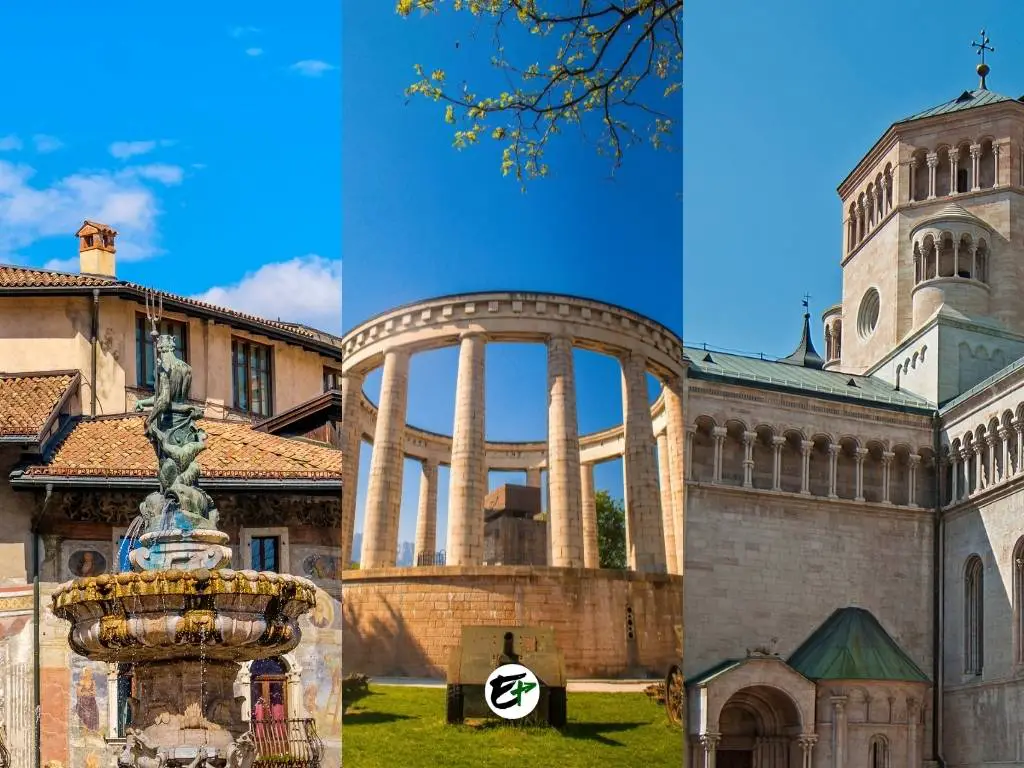
Use the table of contents to skip to topics.
In summary, we can describe the experience in Trento as diverse and fascinating. Every part of the city invites you to step into a world where history meets modernity against the backdrop of Italy’s stunning landscapes.
Situated along the Adige River, Trento is perfectly positioned between Verona and Bolzano. This prime location makes Trento an ideal starting point for exploring the Italian Alps and immersing oneself in the rich culture of Northern Italy.
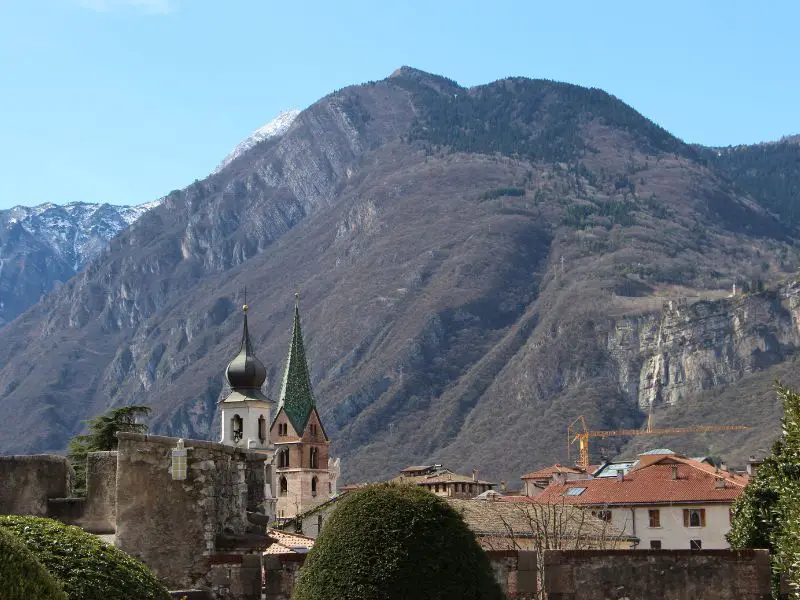
If you need a place to stay in Trento, you can find the best hotel deals in Trento here.
15 Best Things to Do in Trento
Trento presents a wide range of experiences that span history, architecture, archaeology, and most notably, nature. This unique blend is what distinguishes Trento as a destination that’s waiting to be discovered. While there are countless experiences to be had in Trento, here are the top 15 unmissable things to do that I’ve found (see below).
- Admire Piazza Duomo of Trento
- Appreciate the Medieval Cattedrale di San Vigilio
- Visit Buonconsiglio Castle Museum
- Get amused in Trento in Gallerie di Piedicastello
- Uncover the history and lovely views in Doss Trento
- Stroll along River Adige in Trento (Parco delle Albere)
- Discover Trento’s Museo delle Scienze
- Take the cable car to Sardagna
- Explore Orrido di Ponte Alto near Trento
- Enjoy the views in Cima Paganella near Trento
- Be amazed by Terrazza delle Stelle
- Uncover tranquility in Castel Toblino
- Get to the impressive Arco Castle
- Visit Lake Garda from Trento
- Get fascinated by Arte Sella (An open-air museum)
These activities are sorted by distance from the city center, beginning with the closest. This list will simplify your itinerary planning for Trento. The 15 things we’ve suggested to do in Trento can be grouped into three categories:
-
Activities within Trento city center – these are the places you can visit on foot from one place to another in Trento.
- Piazza Duomo of Trento
- Cattedrale di San Vigilio
- Buonconsiglio Castle Museum
- La Gallerie di Piedicastello
- Doss Trento
- Parco delle Albere
- Museo delle Scienze
-
Optional things to do in Trento city center
- Cable car to Sardagna
- Orrido di Ponte Alto
-
Places to visit from Trento main city – these places need a ride on public transportation or car to get to, however.
- Cima Paganella
- Terrazza delle Stelle
- Castel Toblino
- Arco Castle
- Lake Garda
- Arte Sella Open Air Museum
You can find more things to do in Trento here.
Now, Let’s discuss each of them one by one:
1. Admire Piazza Duomo of Trento
Just a 7-minute walk from the train station, you’ll find the vibrant Piazza Duomo, the heart of Trento. This is the perfect starting point for your Trento adventure, especially if you’re starting your day without breakfast.
The Piazza Duomo is dotted with cafes and restaurants where you can fuel up for a day of exploration. But it’s not just about food. The Piazza Duomo is a feast for the eyes too, with plenty to see and do. As the civic and religious center of town, it’s home to some of the most significant and stunning buildings in Trento.
And the best part? Exploring it won’t cost you a dime!
Swipe the 360-view image to see the entire Piazza Duomo:
Fountain of Neptune

At the heart of Piazza Duomo, you’ll find the imposing Fountain of Neptune. The Fountain of Neptune has been a centerpiece of the square for over two and a half centuries. Its water has remained clean and fresh for centuries, thanks to an ordinance as old as the fountain itself that requires everyone to keep it clean.
This grand fountain is a key landmark in the square; a favorite spot for tourists to capture their Trento memories in photos and selfies. You can take photos, too, but please no washing of hands! 🙂
Cathedral of Saint Vigilio
Just south of the fountain lies the Cathedral of Saint Vigilio, a place steeped in Catholic Church history. The cathedral’s size alone is impressive.
While its exterior design, apart from the Apse, is fairly standard, its facade stands out. We’ll delve into the treasures housed within the Cathedral of Saint Vigilio in the following section.
Palazzo Pretorio and Torre Civica
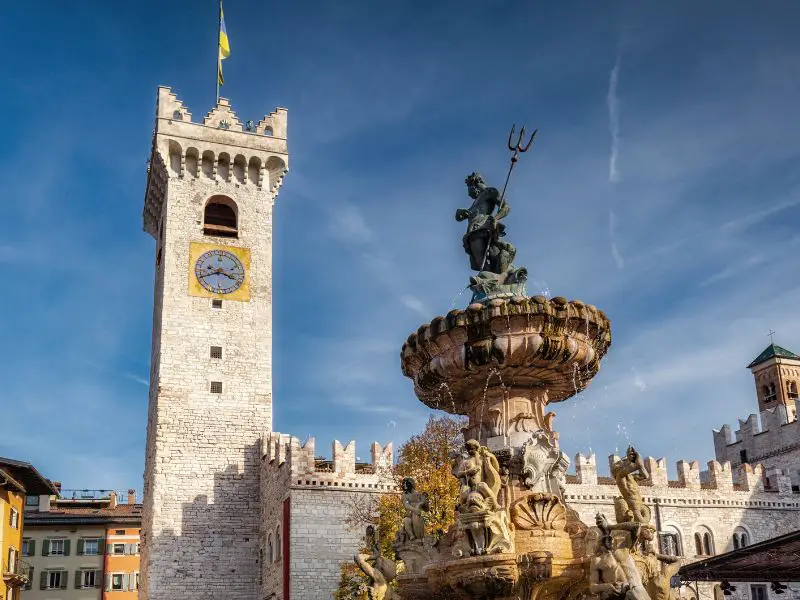

Beside the Cathedral of Saint Vigilio, you’ll find the Palazzo Pretorio and Torre Civica, which were once the home of the city’s bishop princes and administrative tribunals. Today, it houses the Tridentine Diocesan Museum, where you can explore the artistic heritage of the Trento Diocese.
The highlight of the Tridentine Diocesan Museum is the artworks showcasing the iconography of the Council of Trento. You’ll find an extensive collection of items from different eras (12th to 19th century), including liturgical vestments and remarkable tapestries. Personally, I find the cathedral’s illuminated manuscripts displayed in the museum most intriguing.
The early 16th-century tapestries of the Passion of Christ by Pieter Van Edinghen are also worth a look!
If you’re thinking about visiting the Tridentine Diocesan Museum, I suggest checking out their official website first.
They have all the information you need to know before you go, like announcements and entry requirements. However, here’s the summary of the information the last time I checked their official website. For adults, entry is 7 EUR, but on the first Sunday of each month, it’s free!
Keep in mind that the museum is open from Wednesday to Sunday, as well as Monday, from 10:00 am to 6:00 pm, with a one-hour lunch break at 1:00 pm. The museum is closed on January 1 and 6, June 26, November 1, December 25, and Easter Sunday.
Casa Cazuffi and Casa Rella
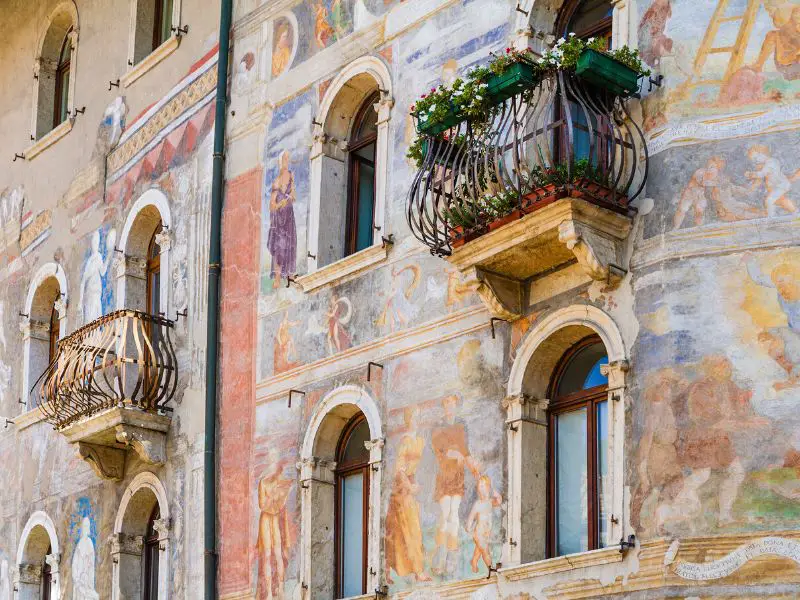
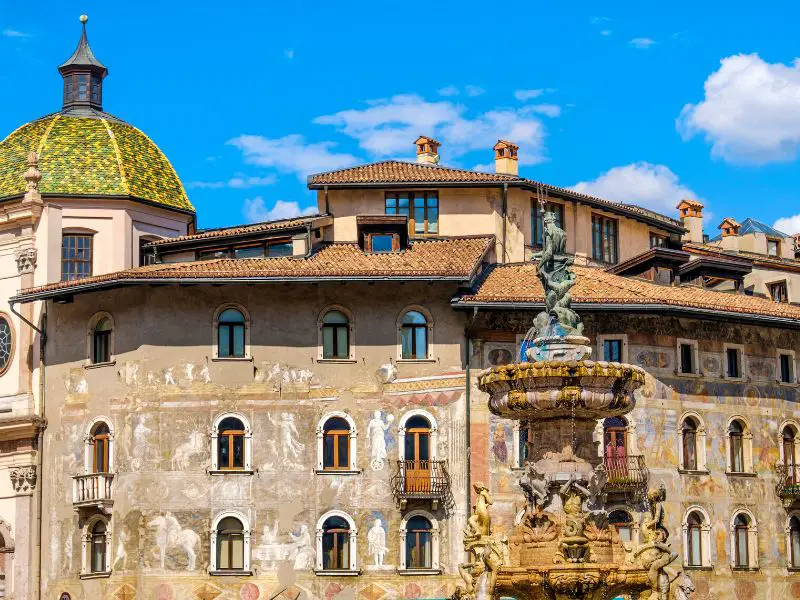
Lastly, don’t miss the opportunity to explore the two remarkable houses located north of the Piazza Duomo, near the Torre Civica. Known as Casa Cazuffi and Casa Rella, these houses feature stunning murals that are reminiscent of the Lüftlmalerei style commonly found in Tyrol, Austria and southern Germany.
2. Appreciate the Medieval Cattedrale di San Vigilio
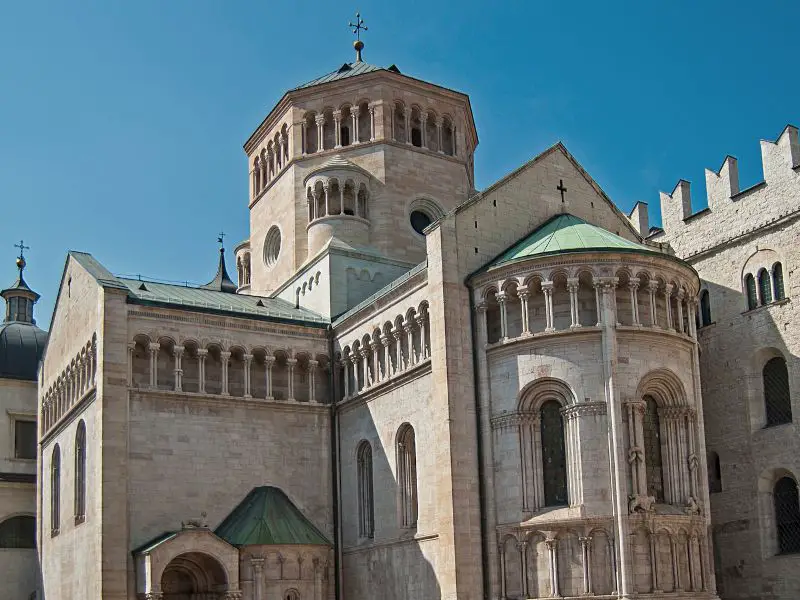
The second thing to do in Trento is also located right there in the city’s square: The Trento Cathedral, also known as the Cathedral of Saint Vigilio.
Originally built in the Romanesque style, the cathedral underwent several modifications over the course of its long construction. Its construction took five centuries to complete, beginning in the early 13th century. One of the most notable is the statue of the Madonna degli Annegati (Madonna of the Drowned).
Although the Cathedral of Saint Vigilio may seem like an ordinary church from the outside, it has many surprises in store for those who explore it. Unfortunately, most of the cathedral’s artworks have been moved to a museum for safekeeping.
What’s the most notable thing about Trento Cathedral?
Well, in the mid-16th century, the Cathedral of Saint Vigilio was the host of the ecumenical Council of Trent for the Catholic Church. This momentous event provided answers to doctrinal challenges posed by the Protestants. If you want a glimpse into what it was like during such an important event, you can see the painting of the ecumenical council inside the cathedral.
But that’s not all the cathedral has to offer.
Inside, you’ll find religious artworks, frescoes, and Byzantine-style murals that are truly nostalgic to see. Don’t forget to check out the side altars, staircase, and cathedral crypt.
Explore the crypt here:
To me, the most intriguing part of the Cathedral of Saint Vigilio is the crypt. It can be a little spooky walking among the tombs, but the relics, stone inscriptions, and artwork are well worth the visit.
If you’re planning to stop by, make sure to check Trento tourism’s official website for opening hours and announcements. The cathedral is open from 6:30 am until 8:00 pm, with a two-hour lunch break starting at noon. Note that the crypt is only open in the afternoon.
3. Visit Buonconsiglio Castle Museum
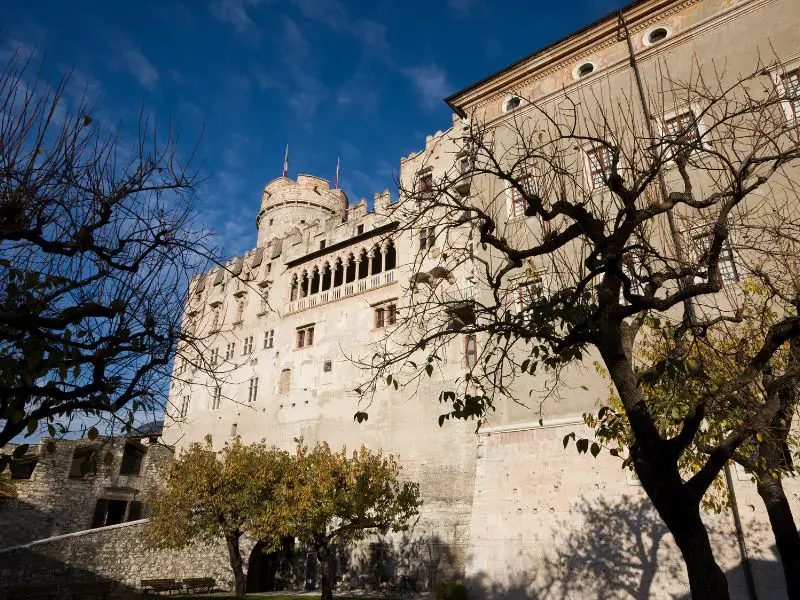
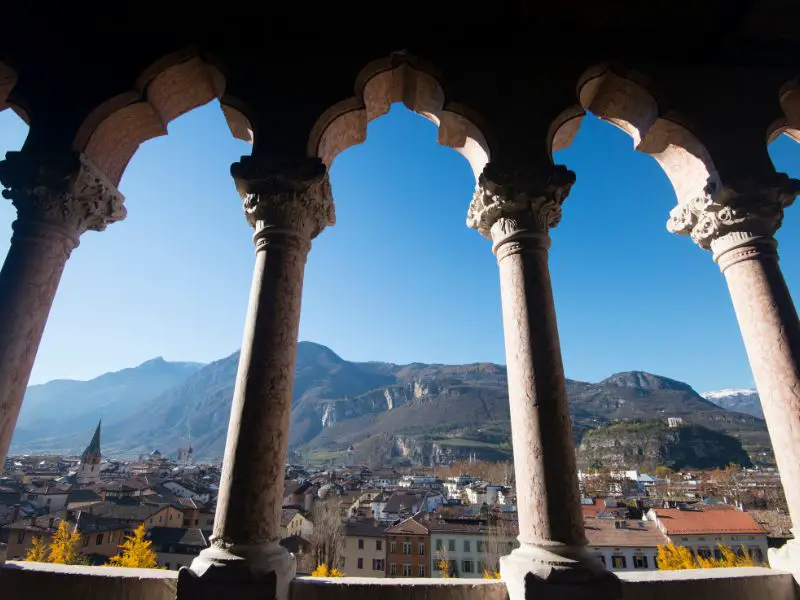
If you’re looking for a fascinating historical site to visit in Trento, I highly recommend Buonconsiglio Castle. Inside, you’ll find collections from various eras that are sure to transport you back in time. With its medieval appearance and impressive treasures, Buonconsiglio Castle is a must-see attraction.
Located just a stone’s throw away from the city center, this castle-turned-museum was once the residence of prince-bishops, like the Palazzo Pretorio. The castle is divided into four main parts, each with its own unique theme, so there’s plenty to explore. Plan on spending at least 3-4 hours there to fully appreciate everything the castle has to offer.
The four parts of Buonconsiglio Castle are:
- Old Castle (Castelvecchio)
- The towers
- Magno Palazzo
- Giunta Albertiana
All the visiting information can be found on Buonconsiglio Castle Museum’s website.
I recommend visiting their site for updates/announcements and requirements before entering. Nevertheless, here are quick info on visiting the museum:
- Entry fee: 10 EUR
- Open from Tuesday to Sunday except for holidays (see website for more information)
- Opening hours vary by half an hour to an hour for different seasons. But you should find the museum open from around 10:00 am to 6:00 pm.
Castelvecchio
The Old Castle, also known as Castelvecchio, was the first part of Buonconsiglio Castle to be built.
Originally, it served as a military fortress to protect the entire city, which is why it’s perched high above Trento overlooking the River Adige. Castelvecchio’s Gothic doors, merlons, and defensive features give it an enchanting fairytale feel that will transport you to the middle ages. If you’re a fan of medieval movies or TV series, being here will help you feel like one of the characters.
Be sure to check out the open gallery in the courtyard to see stunning sculptures, inscriptions, and breathtaking frescoes that provide a more insightful discovery of the castle. For me, the best part of Castelvecchio is the Venetian Loggia.
Although it’s just a small opening in the facade of the old castle, the views from it are spectacularly scenic.
From the Venetian Loggia of Castelvecchio, you’ll see the spires of churches and medieval towers jutting out on the skyline of Trento. You’ll also get to enjoy the tranquil mountains of the Alps in the distance! The view will leave you feeling like you own the city, just like the prince-bishops did in the past.
Giunta Albertiana
Castelvecchio is located in the northernmost part of the Buonconsiglio Castle Museum, and is the medieval section of the entire structure.
To the south of Castelvecchio is Giunta Albertiana, which happens to be the smallest part of the museum. Giunta Albertiana has two floors and is the connecting point between Castelvecchio and the renaissance part of the museum, which is the Magno Palazzo. Giunta Albertiana boasts some truly fascinating frescoes and stuccoes that depict stories of war, religion, and mythologies.
Two of the most notable works of art in Giunta Albertiana are the Triumph of the Christian Faith and Minerva banishing the Sins Back to Hell.
Magno Palazzo
The Buonconsiglio Castle Museum is home to many awe-inspiring artworks, most of which are found in the Magno Palazzo. Every room in the palace boasts stunning frescoes that touch on a wide range of subjects, from myth and religion to fashion and human nature.
The frescoes even depict the extravagant lives of the bishops who once stayed in the palace, and can be found in every nook and cranny, including the narrow corridors.
And if Castelvecchio has the famed Venetian Loggia, Magno Palazzo has the equally impressive Loggia del Romanino. While it may not offer the same stunning views as the Venetian Loggia, the Loggia del Romanino is truly picturesque and will take your breath away.
The light streaming in from outside further adds to the beauty of the scene in the loggia, making it the most impressive part of the palace in my opinion. See the Loggia del Romanino in 360-view:
When you look up at the ceiling of Loggia del Romanino, you’ll see frescoes painted on every inch of the surface. But undoubtedly the most impressive one is the one right in the middle of the loggia – it depicts Phaethon in the sun chariot.
Some of the frescoes use the Trompe-l’oeil art technique, which creates a 3-dimensional optical illusion that’s sure to leave you in awe.
Torre del Falco and Torre Aquila
As you wander through the halls of Magno Palazzo, be prepared to lose yourself in the stunning frescoes adorning every room. But the spectacle doesn’t stop there – at the southern end of the Buonconsiglio Castle Museum lie the castle’s second and third towers, known as Torre del Falco and Torre Aquila.
These towers boast even more breathtaking frescoes, depicting the lives of medieval noblemen. You’ll see them exploring the wilderness, hunting in beautiful landscapes and forests, and enjoying the country life.
While both towers have a similar theme, you’ll likely find yourself drawn to Torre Aquila. This tower is home to the famous fresco, Cycle of the Months, which depicts the flow of time and changing seasons in a truly fascinating manner.
4. Get amused in Trento in Gallerie di Piedicastello
Looking for something fun to do in Trento?
Well, there’s a great museum and attraction on the other side of the Adige River that’s definitely worth checking out. It’s called Le Gallerie di Piedicastello, or The Piedicastello Tunnel, and it’s located just west of the Buonconsiglio Castle Museum.
If you’re looking for a comfortable ride, hop on buses #1 and #6 to get there from Buonconsiglio Castle Museum or Piazza Duomo. But if the weather is nice, you might enjoy walking instead – both attractions are within walking distance of each other.
So, what is Le Gallerie di Piedicastello all about?
It’s a museum that’s been created in an old tunnel. Inside, you’ll find some of the most incredible photographs from the world wars, as well as historical objects that were used for military purposes – like weapons, tools, flags, and more.
Le Gallerie di Piedicastello is a museum that’s perfect for those fascinated by the events of the first and second World Wars. While some of the old films and pictures on display can be quite moving, others can be a bit unsettling. There aren’t any English explanations provided, but the archives speak for themselves.
The museum is divided into two galleries: the black tunnel and the white tunnel, both of which are connected and stretch for 300 meters. And the best part? There’s no admission fee!
The museum is open from 9am to 6pm, Tuesday to Sunday. Before you go, I recommend checking the Le Gallerie di Piedicastello website for any announcements or requirements you should know about.
Le Gallerie di Piedicastello is actually located beneath a hill known as Doss Trento. As you approach the gallery, you’ll notice a fascinating white circular building perched atop the hill. This building is actually the National Historical Museum of the Alpine Troops, which is the next must-see destination we’ll be discussing in Trento.
5. Uncover the history and lovely views in Doss Trento

The National Historical Museum of the Alpine Troops in Doss Trento is a great complement to Le Gallerie di Piedicastello, and vice versa. As the name suggests, this museum offers a fascinating look at military life in the Alps.
If you’re up for a hike, you can reach the top of Doss Trento in just 25 minutes from Le Gallerie di Piedicastello – just be prepared for a lot of stairs! If you’d rather drive, it’ll only take you 5 minutes to get to the top, and there’s a small parking area available.
To find the museum from Le Gallerie di Piedicastello, simply follow the road away from the roundabout or River Adige. Keep an eye out for a sign that says “to Doss Trento” on your right, and you’ll be on your way up to Doss Trento in no time.
The National Historical Museum of the Alpine Troops in Doss Trento is a must-visit destination for those interested in mountain warfare. Not only can you discover new things, but you can also enjoy a breathtaking view of the Alps and the city of Trento.
The museum is dedicated to the Alpini, the Italian Army’s specialist mountain infantry. It features a 1,400-square-meter park and museum showcasing the troops’ armory, awards, uniforms, pictures, and paintings. Visiting the museum offers a deep insight into the troops’ lives.
If you’re looking for inspiration to visit, I recommend watching the movie The Silent Mountain (2014).
Even if alpine warfare isn’t your thing, you won’t want to miss the breathtaking scenery from this site. From the top, you’ll have stunning views of Trento as well as the snow-capped mountains beyond.
In fact, I’d say it’s one of the best spots in Trento to take in the beauty of the Adige River. As you explore the park, you’ll come across cannons, statues of soldiers, and a charming mausoleum.
You can’t miss the white structure which is visible from the road leading to Doss Trento. In addition to those highlights, you’ll also find the ruins of an old church, fascinating stone inscriptions, and plenty of natural beauty to satisfy your wanderlust.
Just like Le Gallerie di Piedicastello, admission to the National Historical Museum of the Alpine Troops is free.
It’s always a good idea to check the museum’s official website before you visit to see if there are any announcements or changes to their hours of operation. As of now, the museum:
- Open from Tuesday to Sunday, closed on Mondays and during the Christmas season (see official website)
- Tuesday to Thursday’s opening hours is 9:00 am until 4:00 pm, 12:00 pm to 1:30 pm lunch break.
- Friday opening hours are 9:00 am until 12:00 pm
- Saturday and Sunday’s opening hours are 9:00 am until 5:00 pm, 12:00 pm to 1:30 pm lunch break.
The best time to explore Doss Trento and other scenic spots around Trento is during the Golden Hour. This is the time of day when the sun is at a perfect angle, casting a golden to orange hue across everything it touches. You can usually catch this moment during sunrise or sunset, when the sky is crystal clear. Not only is this the perfect time for photos, it’s also the least crowded time.
So, if you’re lucky enough to witness this spectacular view, you can enjoy the peaceful atmosphere all to yourself, without the noise and bustle of other tourists.
6. Stroll along River Adige in Trento (Parco delle Albere)
If you’re looking for a peaceful way to enjoy nature in Trento, the bike and pedestrian lanes along Adige River are hard to beat. The path is wide and open, with the majestic mountains around Trento serving as a picturesque backdrop.
It’s one of my favorite free activities in Trento, and I highly recommend it to anyone looking for a little relaxation.
Best of all, the path isn’t usually crowded, so you can find some peace and quiet to enjoy the soothing sound of the flowing river. But the real highlight is the stunning view of the mountains, which adds the perfect touch to this already tranquil hiking experience.
The pedestrian path runs along the east bank of the River Adige. To reach it from Doss Trento, you’ll need to cross the river first. The path is lined with trees, which provide welcome shade on hot, sunny days.
As you make your way along the path, you’ll pass by the cable car station that goes up to Sardagna. We’ll discuss that in more detail in the following sections.
The pedestrian path on the east bank of River Adige in Trento is nearly 3 kilometers (1.8 miles) long, but I recommend stopping your stroll when you reach Parco delle Albere. This lovely park is only a one-kilometer (0.62 miles) walk or 15 minutes away, and it’s a fantastic place to take a break.
The park is spacious and very green, especially on a clear spring day. You’ll find children playing and adults exercising in some parts of the park.
I brought you here to Parco delle Albere because it’s very close to the next best thing to do in Trento: MUSE.
The park also has shops and cafes where you can grab a bite to eat or some refreshments.
7. Discover Trento’s Museo delle Scienze
What’s really surprising about Trento being a city in the Alps is MUSE, a delightful high-tech interactive museum about science and natural history.
I thought Trento would only be a destination for history and nature lovers, but I was partly wrong.
MUSE, or the Museum of Sciences, is a vast museum that spans about 19,000 square meters, filled with countless new things to discover that all revolve around the relationship between humans and nature. MUSE is one of the best things to do in Trento for its unique and fascinating experiences.
In fact, if you plan to visit the Dolomites after Trento, MUSE will give you a good orientation on what you can expect to see in that spectacular place. MUSE has 6 floors, each with different themes and topics. You’ll learn so much about the Alps on the second, third, and fourth floors of MUSE, I promise!
Actually, MUSE has 7 floors, but the highest one is just a panoramic terrace. Here’s what you can see for each level of MUSE:
- (-1) Basement – Evolution of life, worth 5 million years of discovery
- (0) Ground Floor – The interactive displays and exhibits about basic science
- (+1) First Floor – The prehistoric life of humans in the alpine region.
- (+2) Second Floor – All about the Dolomites and how it was formed to how we can protect the mountains
- (+3) Third Floor – The beautiful biodiversity in the alps
- (+4) Fourth Floor – All about glaciers, peaks of the mountains, and the living organisms in them.
It’s best if you can join a tour in MUSE. You get a good sequence, a story, of things you’ll discover in the museum. MUSE offer guided tours in English but not all the time. Check out the schedules and the topics from the official website of MUSE.
There will be a lot to see in MUSE. You will be given 3 hours to see everything inside the museum. Expect to see impressive exhibits, from a dinosaur’s skeletal system to a replica of a prehistoric kid holding a platypus (not sure what animal that is, haha!). Before you visit, be sure to check for announcements/requirements posted on the visiting information page of MUSE Trento.
As of this writing, admission is only permitted with tickets purchased online. Here is a list of quick information:
- Full price ticket: 11 EUR
- Open Mondays to Sundays (see the holiday schedule on their website)
- Entry to Discover Maxi Ooh! needs a separate ticket.
8. Take the cable car to Sardagna.
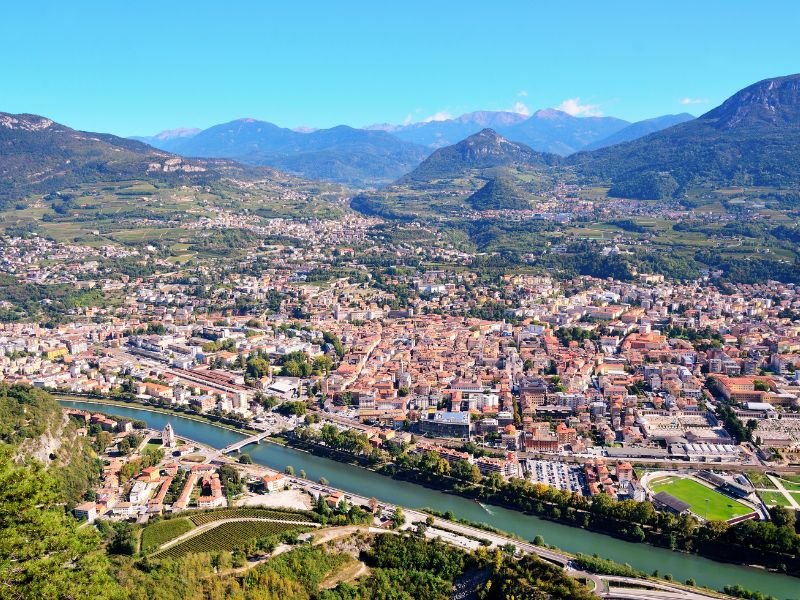
When it comes to reasons to visit Trento, the panoramic views of the city from the nearby hills and cliffs are truly breathtaking.
We mentioned Doss Trento earlier as one spot where you can take in these vistas, but there’s another option: Sardagna, a charming village perched above the rocky outcrop to the west of Trento’s city center. If you’re like me and can’t resist a stunning view, then taking a cable car to Sardagna should be at the top of your Trento to-do list.
Of course, if you’ve already seen the view from Doss Trento, this can be an optional activity. But if you do make the trip up to Sardagna, you’ll be rewarded with an observation deck and a truly splendid view of Trento.
How does it compare to the view from Doss Trento?
While it’s only slightly higher, you’ll be able to see the mountains to the north from there. In Sardagna, you’ll only see the city and the mountains to the east, but it’s still a breathtaking sight to behold.
What makes the observation deck in Sardagna better than Doss Trento?
Well, there’s a cozy cafe nearby, and with the cable car, you can easily reach the spot without breaking a sweat. It’s the perfect place to unwind and spend some quality time with friends or loved ones. If you’re interested in taking a gondola ride, it costs only 5 EUR per person.
To check if the gondola is running or to find its operating hours, simply visit the official website of Trentino Transport.
At the moment, the gondola runs from 7:25 am to 10:25 pm on weekdays, and from 11:30 am to 8:10 pm during holidays. In case the cable car isn’t operational, there’s always a bus service substitute available. For more information, check out the link I mentioned earlier.
9. Explore Orrido di Ponte Alto near Trento
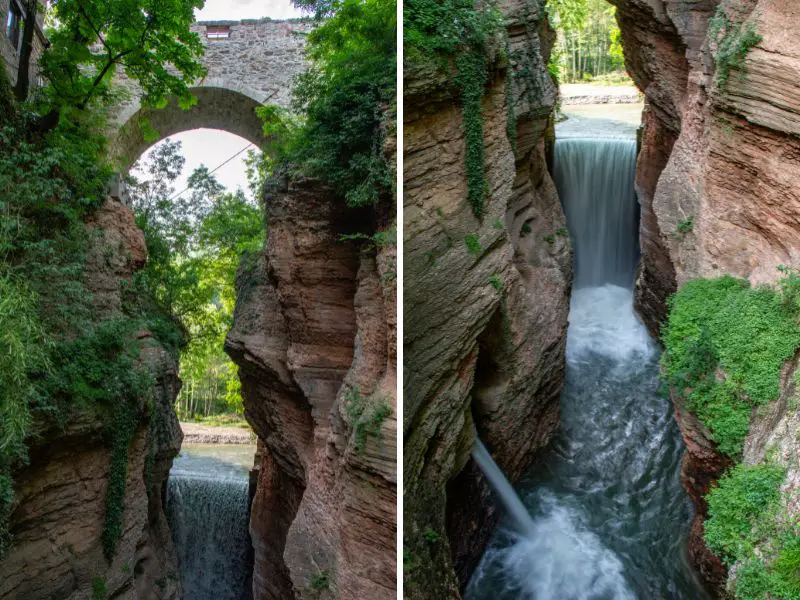
Nestled in the majestic Alps, Trento boasts a breathtaking landscape that extends beyond what meets the eye (from the town).
Hidden gems like gorges offer visitors a glimpse of Trento’s natural wonders, and one such gem is the Orrido di Ponte Alto. This gorge is a testament to both the ingenuity of man and the power of nature.
Over thousands of years, the Fersina stream carved its way through the rocks, shaping the canyon into a work of art. To prevent devastating floods during heavy rainfall, the residents of Trento intervened and transformed the gorge into a marvel of engineering. Today, visitors can marvel at the two massive 40-meter waterfalls that cascade into the meandering chasm, forming an impressive water curtain.
The walls of the gorge bear witness to the relentless power of erosion, etched with fascinating patterns that make the visit all the more worthwhile.
Though the gorge is located 4 kilometers from the city, a quick bus ride or a Google Map route (which you can find at this link) will take you right to the site.
- From Trento train station, hop on bus #9 and drop by Cognola Grezoni.
- From Cognola Grezoni station, proceed to Via Grezoni. You shall find road signs directing you to Via Grezoni once you alight the bus.
- When you reach the end of Via Grezoni, you arrive at Via Ponte Alto and turn left.
- Walk along with Via Ponte Alto without turning to any other streets.
- Continue walking for about 10 to 12 minutes, and you shall find an old restaurant with “CASCATA di PONTE ALTO” written on its facade. The restaurant is also called La Gnoccata.
- Beside La Gnoccata is the entrance to the Orrido di Ponte Alto.
Beside La Gnoccata and the sports complex along Via Ponte Alto, you’ll find a parking lot. However, I highly recommend taking the train to avoid the hassle of finding a parking space.
Admission to the gorge is 5 EUR for adults and 3 EUR for kids aged 6 to 12. Children younger than that get in for free, but it’s important to note that you can only explore the gorge with a guide. Guided tours are available on Saturdays and Sundays, starting hourly from 10:00 am until 6:00 pm.
Before visiting, I strongly suggest checking the announcement page to stay updated on any changes or closures.
Keep in mind that weather and other factors may affect the tour’s operation, so it’s possible that the gorge may be closed when you visit. That’s why earlier, I mentioned Orrido di Ponte Alto as an optional activity.
With that, we’ve covered everything worth doing in Trento. Now, let’s dive into a discussion of activities and places you can visit as soon as you arrive in Trento.
10. Enjoy the views in Cima Paganella near Trento

Paganella is a must-visit peak for anyone travelling from Trento.
At 2,124 meters tall, it’s nestled in the heart of Trentino and offers a breathtaking 360-degree view of the entire region. Paganella is the viewpoint to many different parts of the Italian Alps, from Lake Garda to Brenta Dolomites, Adige Valley, Pale di San Martino, and more! You won’t regret taking in the rugged peaks of the Dolomites.
But Paganella isn’t just about the view. The slopes on this mountain are perfect for both skiing and hiking, making it a year-round destination for outdoor enthusiasts of all ages and skill levels. And when you need a break, you’ll find a café or lodge where you can indulge in delicious food and drink while soaking up the stunning surroundings.
Your eyes and your tummy will both be satisfied.
You don’t have to go on a strenuous hike just to reach the top of Paganella. If you start from Andalo, which is the nearest town or village, you can simply ride a cable car that will take you straight to the summit of the mountain. To get to Andalo from Trento, you can take bus #B611 from the train terminal, which will take around 1 hour and 9 minutes.
For more travel options, you can check out the Trentino Transport website.
Andalo has plenty of attractions like amusement parks, mountain parks, and aqua parks that you can explore before heading to Cima Paganella. If you’re traveling with kids, they’ll surely enjoy the Andalo Life amusement park!
11. Be amazed by Terrazza delle Stelle
The mountains offer the best view of the stars and galaxies beyond our own. The remote location, free from light pollution, allows the stars to shine brightly like nowhere else.
That’s why MUSE, an astronomical observatory, built its facility away from the city center in the Viote basin near the summit of Monte Bondone. The observatory, named Terrazza Delle Stelle or Terrace of the Stars in English, boasts powerful telescopes with an 80 cm diameter Newtonian reflector.
Expert guides accompany visitors in using the telescopes to explore the stars beyond our galaxy at night. During the day, visitors can safely observe the sun thanks to special filters in the telescopes.
Visiting the observatory is a must-do experience in Trento. In the center of it all, you’ll find a stunning polished steel dome offering breathtaking views of both the surrounding landscape and the enchanting night sky above. The dome’s surface reflects light like a blob of Mercury dropped on top of an elevated valley, dazzling your senses day or night.
Best of all, admission to the site is completely free, making it an accessible destination for all. In addition to the observatory, there’s also a beautiful botanical garden and a fun amusement center nearby. And if you need a quick snacks, there’s a cafe near Terrazza Delle Stelle as well.
If you’re looking to explore the instruments on site, be sure to check for events or schedule an appointment ahead of time by reaching out to MUSE through their website or email at astronomia@muse.it.
Events are also announced on their official Facebook page.
Keep in mind that while admission is free, there is a fee for activities, with prices starting at just 3 EUR for adults and 2.50 for those with discounted rates.
Terrazza Delle Stelle may be located in the mountains, but getting there is easy with just one bus ride. The B202 bus takes you right to the astronomical observatory. From Trento train station, hop on the bus and get off at Viote.
You can check the schedule and availability of the bus on the Trentino Transport website.
12. Uncover tranquility in Castel Toblino
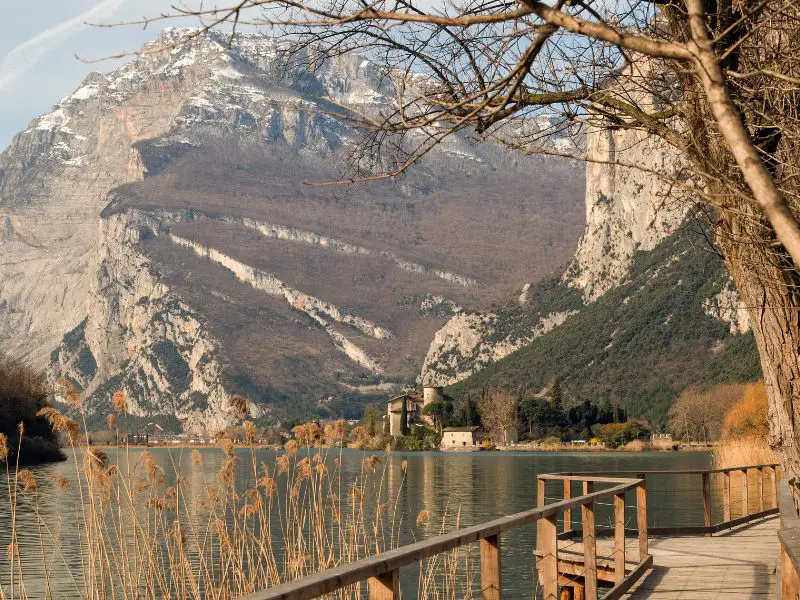
Castel Toblino is hands down one of the most enchanting spots to visit from Trento.
This place is pure magic, with a fairytale atmosphere that’s sure to capture your heart. And why wouldn’t it? There are two major reasons: its history and its location. If you’re a lover of wandering and photography, this is the destination for you!
Castel Toblino has a rich history that dates back to the 16th century, when a fortress was built on the promontory in Lake Toblino. But the castle’s lore goes back even further, with legends and myths that span over 2000 years. Some say that fairies once inhabited the lake, and that the temple that the castle replaced was dedicated to them.
But what really makes Castel Toblino worth a visit are the stunning mountains and tranquil lake that surround it. Head to the viewpoint for a breathtaking view of the castle, with its reflection in the water and a towering mountain in the background. It’s a sight you won’t soon forget!
Castel Toblino is a renowned castle in Trento, and its beauty is not limited to its exterior. Once you step inside, you’ll be greeted with stunning frescoes and paintings of musical instruments in the music hall, as well as a variety of medieval artifacts. Though it may not be as grand as other castles in Italy, it has a unique quality that will leave you feeling nostalgically enchanted.
As you wander through the castle, you’ll encounter armored statues, iron doors, inscriptions, carpets, and more, each contributing to the castle’s undeniable charm.
If you find yourself feeling hungry, the castle’s restaurant offers a delicious solution, although it should be noted that it can be a bit pricey. Nonetheless, the breathtaking views and ambiance make it well worth the cost, especially on hot and sunny days when their refreshing drinks are particularly tempting.
It’s important to note that the castle doesn’t accept walk-in visitors at this time, so you’ll need to make an appointment and reserve a date and time to gain entry. For further details, you can email the castle’s administrator at associazionecasteltoblino@gmail.com, or check their website for the latest updates and opening hours.
Of course, even if you can’t get inside, the surrounding area is still well worth exploring; Lake Toblino boasts some truly stunning hiking trails, with much of the path paved for ease of travel, and plenty of boardwalks (perfect for your Instagram feed!) to be found along the way.
Visiting Lake and Castel Toblino is a breeze! It’s just a single bus ride away from Trento. Simply catch bus #B201 from the train station and disembark at the Castel Toblino bus stop, which takes about 30 minutes. And if you’re coming from somewhere else, no problem! Buses #B204, #B205, and #B215 also pass through Castel Toblino.
13. Get to the impressive Arco Castle
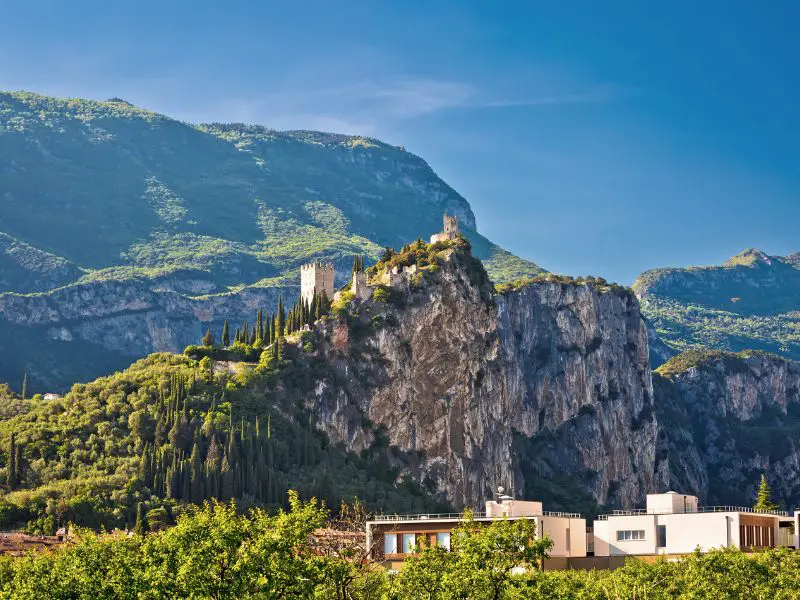
If you’re looking for another castle to explore from Trento, Castel Arco in Arco is definitely worth a visit. Unlike Castel Toblino, Castel Arco is perched on a hilltop, offering spectacular views both from afar and within. Although the castle is already in ruins, I think that’s what makes the experience unique.
By wandering through the crumbling walls, arches, and stairways, you’ll feel transported to a different time and place.
The scenery from Castel Arco is straight out of a movie, with dramatic views that will satisfy your wanderlust. From the top of the castle, you’ll see an incredible panoramic view of the town of Arco, the surrounding fields and mountains, and even Lake Garda in the distance.
While some parts of the castle may have already succumbed to the effects of time, the tower, venerable halls, and prison have been expertly preserved. You won’t want to miss the frescoes that adorn the walls of the castle either. They feature knights, court ladies, aristocratic men, and Saint George slaying a dragon.
Before you go, be sure to check the visitor’s information page of Arco Castle for any announcements, updates, or requirements. The page is written in Italian, but don’t worry–here’s a short version in English:
Admission
- Adults: 3.5 EUR
- Children/Teens (12 to 18) and Senior (60+): 2 EUR
- Below 12: Free
Opening Hours
- Summer opening hours (from April to September): 10:00 am to 7:00 pm
- March and October: 10:00 am to 5:00 pm
- Winter opening hours (November to February): 10:00 am to 4:00 pm
- January (after Epiphany) and February: 10:00 am to 4:00 pm (Saturday and Sunday only!)
Important
- Come 1 hour before closing time
- Closed from November 1, December 25 to 26, January 1
- Closed on December 24 and December 31 afternoon
To reach Arco Castle from Trento, hop on bus #B205 at the Trento Train Station and head towards Arco P. Foro Boario. The bus ride takes approximately one hour. Once you arrive, simply follow the path up the hill towards Arco Castle. The hike is only 17 minutes long, so you’ll be there in no time.
For more information on bus schedules and other routes, be sure to check out the Trentino Transport website.
And if you find yourself getting tired or hungry, don’t worry! There are plenty of restaurants located below Arco Castle where you can take a break and recharge.
14. Visit Lake Garda from Trento
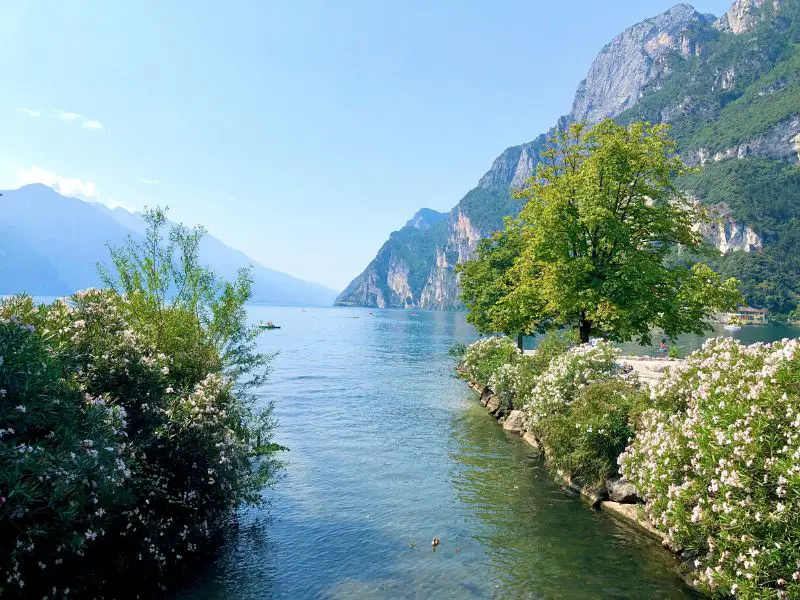
The northern shore of Lake Garda is a destination that can only be described as near-paradise.
Complete with a beach, spectacular views, scenic hikes, picturesque landmarks, and romantic restaurants, it’s no wonder that a visit to Lake Garda is the ultimate thing to do from Trento. If you’re planning a trip, don’t forget to pack your swimsuits!
The beaches at Lake Garda are absolutely stunning, and the towering limestone mountains rising from the glittering surface of the lake will take your breath away. There’s no shortage of fun activities and water sports available on the beach, including canoeing, kayaking, boating, and more. And if you’re a photography enthusiast, you’ll be in heaven here.
From the Instagrammable docks to the adorable ducks, there’s always something to capture with your lens in every direction, especially on sunny days.
Lake Garda is the largest lake in Italy, spanning 370 square kilometers (or 143 square miles) with a plethora of sites to be discovered on all sides. Boat tours are available to explore the beautiful areas around Lake Garda.
On the northernmost shore, you’ll find two charming towns: Riva del Garda and Nago-Torbole. If you’ve already made it to Arco Castle, these towns are just a quick 15 to 20 minute drive away.
- Bus #B863 – Arco to Riva del Garda
- Bus #484 – Riva del Garda to Torbole
Going to Lake Garda straight from Trento? Hop on bus #B205 or #B301 from the Trento station and drop by Riva Del G. Autostaz. It’s an hour and 30 minutes of travel time. You can check the bus schedule and alternative routes from the Trentino Transport website.
For a detailed discussion about Lake Garda, my two articles come handy: Lake Garda Guide (Reasons to Visit) and 3-Day Lake Garda Itinerary.
15. Get fascinated by Arte Sella (An open-air museum)
If you’re looking for something truly special to do in Trento, look no further than Arte Sella. This open-air art museum showcases contemporary works of art made from all-natural materials.
The exhibits are absolutely enchanting, and you’ll find yourself wanting to snap photos of all the masterpieces you see. Describing each artwork would be difficult, so I’ve included a video below that will give you a sneak peek of the awe-inspiring things that await you at Arte Sella:
Art Sella is situated in the charming town of Borgo Valsugana, which is about 40 kilometers east of Trento. Unfortunately, there is currently no public transportation available to reach the park. The only way to visit is by car, and the drive from Trento takes approximately one hour.
If you’re planning a trip, be sure to check out the “How to Reach Us” page on Art Sella’s website for helpful information on car parks, taxi services, bicycle rentals, and more.
Admission to Art Sella is 8 EUR for adults and 4 EUR for kids aged 11 to 16.
The park features two scenic routes to explore: Malga Costa and Villa Strobele Garden. Both routes are open year-round from 10:00 am to 5:00 pm, with extended hours until 7:00 pm during the summer months.
Just remember to arrive at least one hour before closing time to ensure you have enough time to enjoy the park to the fullest! Lastly, before you visit, make sure to check Art Sella’s Rates and Schedules and their announcements or requirements (Green Pass, etc.)
Map of Things to Do in Trento
Below are the locations of each destination in the list of best things to do in Trento mentioned in the previous section.
See more things to do in Trento from this link.
When to Visit Trento
So, when should you visit Trento? Well, that depends on what you’re looking for.
If bustling streets and outdoor adventures are your thing, summer is ideal. Summer is what I suggest visiting Trento because it’s the time when most of the tourist attractions within and outside the city are open to the public. The visiting hours are much longer, letting you have more experiences throughout your trip.
For cooler climes and fewer crowds, consider spring or autumn. And if you’re a fan of winter sports or simply love the tranquility of snow-covered landscapes, winter is your season.
Consider The Weather
Here’s the breakdown for each season:
- As spring unfolds from March to May, Trento begins to bloom. The air is crisp, with temperatures gently rising from a cool 9.4°C in March to a more comfortable 17.3°C in May. It’s a time when the outdoors beckon, perfect for hiking and cycling. But remember, spring showers bring May flowers, so do pack an umbrella.
- When summer arrives, from June to August, Trento basks in the warmth of the sun. Daytime temperatures can peak at 30°C, but the nights offer a cool respite. It’s a season made for thrill-seekers, with canyoning and rafting on the agenda. But be warned, summer also brings the crowds, with July being the peak tourist month.
- As autumn paints Trento in hues of gold and red from September to November, both temperatures and tourist crowds begin to fall. September starts off warm at 21.2°C but cools down over the next months. It’s a time to enjoy Trento’s scenic beauty in relative peace. However, November can be rainy, so don’t forget your raincoat.
- Finally, winter wraps Trento in a blanket of snow from December to February. It’s a season of cold days and colder nights, with temperatures often dipping below freezing. But it’s also a season of fun on the slopes, with the Dolomites nearby offering excellent skiing opportunities. And while winter is the least popular time for tourists, it offers a serene and peaceful experience for those who love the quiet and snow.
Consider the Price
If you’re looking to save money, consider planning your trip during the off-peak season.
This falls between January 1st and April 1st, and again from October 1st to December 16th. During these quieter months, you’ll find that both flight and hotel rates are more wallet-friendly. On the flip side, Trento buzzes with tourists during the summer months, specifically from mid-June to mid-September. As you can imagine, this surge in visitors can cause hotel prices to spike.
To give you a rough idea of the difference in cost (in 2023), a week-long stay in a hotel in Trento during the off-peak season averages around 622 USD (89 USD per night). In contrast, during the peak season, you might find yourself paying an average of $114 per night.
Remember, these are just averages and actual prices can vary.
Factors such as the specific dates of your trip and the type of accommodation you choose can greatly influence the cost.
Consider The Events
For a unique experience in Trento, you might like to consider visiting the city during its festivals and special events.
Here are the top 5 yearly events in Trento that you must consider for planning your trip:
- Trento city of Christmas (November to January): Imagine a city filled with light, music, and art. The scent of wood, mountains, cinnamon, and mulled wine fills the air. It’s a magical atmosphere that you can’t miss.
- IMBA Italia Gathering (October): If you’re a mountain bike enthusiast or care about sustainable territory development, this is the event for you. It’s a celebration of mountain biking and promotes trail network enhancement projects.
- 3Tre – Audi FIS Ski World Cup Night Slalom (December): Picture yourself watching a thrilling men’s night slalom on the Canalone Miramonti. It includes two slalom runs of the World Cup and is sure to get your adrenaline pumping.
- Christmas Markets Levico Terme (November to January): This Christmas Market takes place inside the Hapsburg Secular Park and offers a unique experience of the city’s culture and festivities.
- Christmas in Rovereto (November to January): Known as ‘Natale dei Popoli’ – Christmas of peoples, this event offers gift ideas from different cultures. It’s a unique way to experience the holiday season.
Here’s Trentino’s Calendar of Events in case you want to discover more.
How Many Days in Trento
If you’re just looking to hit the highlights in Trento, like checking out the town center and popping over to nearby vantage points like Sardagna and Doss Trento, you could probably wrap that up in about 2 days. That gives you enough time to soak in the sights, visit museums like MUSE, and still take it easy.
But if you’re thinking of venturing beyond Trento to places like Lake Garda, Castel Toblino, Orrido di Ponte Alto, and Cima Paganella, you might want to block off a long weekend (3 to 4 days) or even a week. That way, you can really take your time exploring all the natural beauty in Trentino, with its stunning lakes and mountains.
And here’s a pro tip: if you’re staying in Trentino for at least 2 days, you’ll get the Trentino Guest Card for free. It gets you into many of Trento’s attractions for free and covers your transport around Trento and its surrounds. Pretty sweet deal, right?
How to Get to Trento
Flying into Italy: When you’re planning your trip to Trento, you’ll find that the closest airports are in Verona (VRN), Bergamo (BGY), Venice (VCE), and Milan (LIN). There’s also a quaint little airport right in Trento, the Trento-Mattarello (G.Caproni) Airport.
From the Airport to Trento: Once you’ve landed, there are several ways to reach Trento:
- From Verona (VRN): Hop on a train and you’ll be in Trento in about 1 hour and 41 minutes.
- From Venice (VCE): Take a scenic train ride from Venice to Trento via Venezia Mestre Station and Verona Porta Nuova. The journey takes around 3 hours and 19 minutes.
- From Milan Bergamo (BGY): FlixBus operates a bus from Bergamo to Trento 3 times a day. The journey takes approximately 2 hours and 30 minutes.
- From Milan Linate (LIN): The journey from Milan Linate to Trento typically takes around 3 hours and 15 minutes.
Traveling from Other Cities in Northern Italy: If you’re already in Northern Italy, getting to Trento is a breeze. The region has an excellent train network that connects many of the country’s top destinations. Just hop on a train from any major city like Milan or Venice, and you’ll be in Trento in no time. The main train stations in Trentino are Trento and Rovereto.
Do You Need a Car in Trento? While renting a car can be great for exploring the Italian countryside, it’s not always necessary. In Trento, most places are within walking distance, so a car may not be necessary unless you plan on venturing outside the city…
Where to Stay in Trento
Where should you stay in Trento? Let’s break it down:
- City Center: Imagine stepping out of your hotel and finding yourself in the heart of Trento, with the Piazza Duomo, Torre Aquila, and Cattedrale di San Vigilio just a stone’s throw away. The city center is bustling with restaurants and shops, offering a vibrant atmosphere. However, this prime location comes with a higher price tag.
- Adige River Area: If you prefer serene river views and a peaceful environment, consider staying near the Adige River. You’ll still be within reach of the city center but away from its hustle and bustle. The trade-off? You might have fewer dining options.
- Outskirts of Trento: For those who love the quiet and don’t mind a bit of travel, the outskirts of Trento could be your haven. Here, you can wake up to views of the Alps and Dolomites without breaking the bank. However, keep in mind that public transportation might not be as accessible.
You can find the best accommodation deals here. The link directs you to a browser for hotels, complete with a map feature. This can be your guide to finding a hotel in Trento that offers both convenience and accessibility.
How to Get Around Trento
Trento’s city center is not just walkable, it’s a delight to explore on foot. The compact nature of the city means you can easily stroll from one attraction to another. If you’re venturing outside the city center, public transport might come in handy.
Public transportation in Trento is both comprehensive and convenient. There are trains, buses, and cable cars. You can check the city’s transport services website (managed by Trentino Trasporti), offering real-time routes and timetables to help you navigate the city with ease.
However, if you’re planning to visit multiple sites (example, Lake Garda, Castel Toblino, and Orrido di Ponte Alto) in one day or have a tight schedule, renting a car could be the way to go. And if you’re bringing your own car, here are three parking options:
- P5 – Parcheggio Duomo: Located at Piazza Ezio Mosna, 1/A, this parking lot is right in the heart of the city. It might get busy during peak hours though.
- Piazza di Fiera: This 24/7 parking lot at Piazza Di Fiera 1/b is another centrally located option. Finding a spot might be challenging during busy times.
- Parking at Via Fersina/Via Bartali: This free parking lot near the BLM Group Arena has 137 spots and even has spaces reserved for disabled drivers.
Remember to always check local signs or ask for information when you park.
Where To Go After Trento?
If you’re currently in Trento, you’re literally only hours away from one of the most spectacular places on earth—the Italian Dolomites.
The beautiful villages, mountains, and lakes in the Dolomites are undoubtedly the best place to go after you visit Trento. You can go straight to Cortina d’Ampezzo (the heart of the Dolomites) or have a stop in Bolzano, the gateway to the Dolomites.
At the beginning of this post, I mentioned that I like historical sites and breathtaking destinations. For northern Italy, I have these articles you can use to discover a new place to visit after Trento:
- Historical Sites
- Venice — is a living remnant of the mighty Venetian Republic.
- Verona — is a romantic city, home of Romeo and Juliet. Here’s an itinerary for a trip to Verona.
- Bergamo — is a medieval city with scenic views. It has a Venetian Wall, a UNESCO heritage site untouched by any wars and conflicts.
- Milan — is a city that’s more than just a fashion capital.
- Florence — is the birthplace of the Renaissance. This city is filled with art and stunning buildings.
- Rome — come here to discover 2000+ years of history.
- Scenic Places
- Lake Garda — is the largest lake in Italy. It has scenic spots, hiking trails, castles, and picturesque towns. Here’s an itinerary for a trip to Lake Garda.
- Lake Como — is a heavenly place. This lake has villas that are straight out of a fairytale!
- Cinque Terre—is the most scenic coast of northern Italy.
If you like visiting beautiful alpine towns and villages like Trento, I suggest you also see the following destinations in Europe:
-
Bavarian Alps in southern Germany — they have beautiful streets with houses painted with Lüftlmalerei, vibrant Bavarian culture, and Germany’s most spectacular natural wonders:
- Berchtesgaden — has a historic salt mine, scenic views from WWII historical sites, beautiful lakes, and picturesque chapels. Learn more: 10 Best views in Berchtesgaden.
- Mittenwald — here you can find the longest ski route in Germany.
- Garmisch-Partenkirchen — is the town closest to Germany’s highest peak and one of the most picturesque alpine lakes.
- Oberammergau — the village famous for its legendary Passion Play.
-
Towns/Villages in the Swiss Alps — rustic villages perched on breathtaking locations:
- Interlaken — The gateway to the Jungfrau region. Here’s how you can spend 1 to 7 days in Interlaken.
- Lauterbrunnen — it is Switzerland’s heaven on earth valley. Check out my 1 to 3-day Lauterbrunnen Itinerary.
- Grindelwald — it’s where family-friendly and most epic adventures in Switzerland are!
- Kandersteg — it is the closest village to Oeschinensee, one of the most beautiful alpine lakes in the Swiss Alps.
- Zermatt — it is the village where you can see the Matterhorn, one of the world’s most famous mountains. Learn more: 10 Best views in Zermatt
-
Cities near the Swiss Alps — They are a strategic home base for visiting different attractions in the Swiss Alps. Come to have a mixed experience: medieval architecture, adventure, wines, scenic views, and more. I recommend you don’t miss:
- Lucerne — it has impressive unique landmarks, a charming historic town center, a scenic lake, and is minutes away from Mount Rigi/Mount Pilatus. Discover: How many days to spend in Lucerne (1 to 3-day sample Lucerne itinerary).
- Montreux — It is unmissable during the Jazz festival! You can visit a fairytale castle, a beautiful vineyard and drink unique wines from here.
- Destinations in the French Alps:
Save it on Pinterest.
